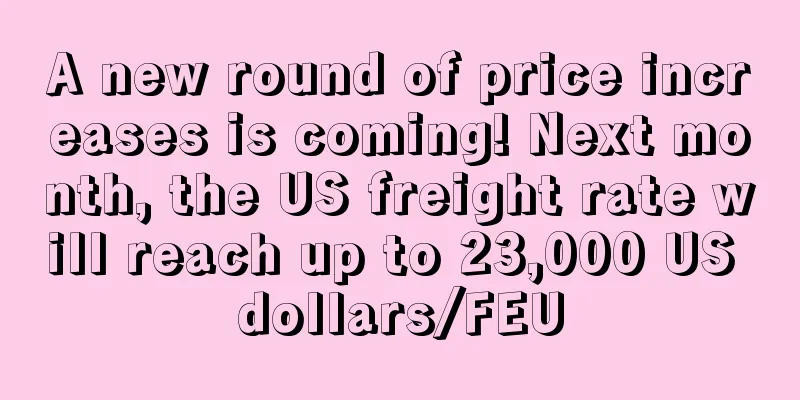A new round of price increases is coming! Next month, the US freight rate will reach up to 23,000 US dollars/FEU

|
The port is jammed! Jammed! Jammed! The cargo volume is increasing! Increasing! Increasing!
The more traffic there is, the more congestion there is. This is the current situation of the three major ports in the western United States! At present, the freight rates of major routes around the world, especially those of the US and Europe, have soared, but it is still in an awkward situation where it is difficult to find a container or a cabin, and there are also frequent problems such as overloaded cabins and abandoned containers!
Freight volume surge and port congestion go hand in hand
According to data released in May by US research company Descartes Datamyne , in April this year , the volume of seaborne container shipments from Asia to the United States increased by 32.1% year-on-year to 1,656,443 . The volume of shipments has increased for 10 consecutive months, setting a new record for the single-month April in previous years.
However, the three major ports in the western United States are still congested. The average waiting time for ships at the ports of Los Angeles and Long Beach is one to two weeks , while the waiting time at the Port of Oakland is even more exaggerated! The waiting time at the Port of Oakland has now been extended to three weeks , and Hapag-Lloyd has even announced that it will skip the port of Oakland.
The industry couldn't help but sigh that the congestion at the Port of Auckland has reached a new height and a new horizon ...
Demand is high, and the freight rate to the United States can reach up to $23,000
The relentless demand for ocean freight and the resulting delays and container shortages have seen spot rates on all major trade lanes hit new highs again in recent weeks.
According to the freight index of maritime analysis agency Drewry , the spot freight rate for a 40-foot container from Shanghai to Los Angeles soared to US$6,000/FEU in mid-April and continued to show an unstoppable upward trend, reaching US$6,358/FEU on Wednesday this week .
But this is just the spot freight rate. The actual cost that shippers will eventually pay is much more than this! After adding up the prices, the actual price on the West Coast is at least $11,000/FEU.
And this is far from the end of the increase in freight costs!
As congestion at ports in Asia and North America is nowhere in sight, the departure and arrival times of ships are further delayed , indirectly leading to a shortage of shipping capacity. Frequent bidding among shippers for space and containers, coupled with rising demand, has forced prices to rise further.
Maersk and Hapag-Lloyd have announced additional charges in the United States and Canada, which will take effect from next week.
According to industry insiders, freight rates on the eastbound trans-Pacific route will surge again next month. Although freight indices such as Drewry currently show that freight prices on the East Coast are around $8,000/FEU, the actual freight to be paid may be in the range of $11,000-20,000/FEU, and may rise to as high as $23,000/FEU.
However, it should be noted that even if you pay such high fees, you may still encounter the difficult situation of tight space and difficulty in finding a container! freight port logistics |
<<: Argentina - the fastest growing e-commerce country in the world
Recommend
This year’s Double 11, AliExpress and spokesperson Ma Dongseok are giving out lucky blind boxes in Korea!
With the arrival of Double 11 overseas , merchant...
Flipkart partners with Mahindra Logistics to accelerate use of electric vehicles for last-mile deliveries
India's largest e-commerce platform Flipkart ...
E-EN's flood prevention and relief operations continue, Weihui hold on!
Fertile fields and houses were flooded, leaving h...
What is ETD? ETD Review, Features
ETD is the acronym for Estimated Time of Departur...
Cainiao and Huaxizi join hands to create a full-link logistics solution for Chinese products going overseas
Recently, in a warehouse of Huaxizi in southern C...
What is Polestar? Polestar Review, Features
Polestar is a Swedish luxury electric car manufac...
Airwallex Wu Kai: Digital economy boosts cross-border trade
The fourth "Belt and Road" Service Trad...
What is Dealspotr? Dealspotr Review, Features
Dealspotr is a social shopping and influencer pla...
What is Doggy Treat Box? Doggy Treat Box Review, Features
Doggy Treat Box is a subscription-based e-commerc...
Amazon Poland launches product promotion function!
Recently, Amazon announced that the Sponsored Pro...
Typhoon "Compass" is about to land in Hainan, and surrounding seaports will suspend operations
Now that we have entered autumn, typhoons continu...
The "cross-border leader" was applied for reorganization by creditors? The latest developments are here
Cross-Border Link, once a thriving distribution g...
What is Samoyed Cloud Technology? Samoyed Cloud Technology Review, Features
Samoyed Cloud Technology Group was founded in 201...
Five people were confirmed to be infected at Shanghai Pudong Airport, and air freight rates may rise again!
As of 8:00 a.m. on August 22, Shanghai had 9 new ...
What is Air Sea Express? Air Sea Express Review, Features
Founded in 1994, Air Sea Express is committed to p...









